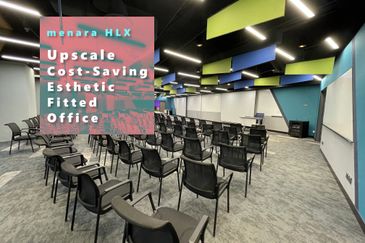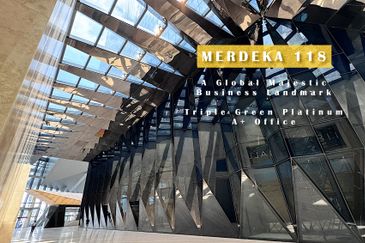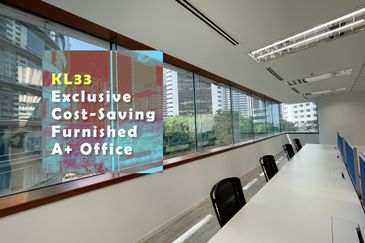
While there was a sharp drop in the volume of transactions across all subsectors in the property market last year, average prices per unit are still increasing 5%, says CBRE | WTW managing director Foo Gee Jen in presenting the Malaysia series of the property consultancy firm’s Asia-Pacific Real Estate Market Outlook for 2017. The number of transactions dipped 12% to 239,798 as at 3Q2016 from 272,550 as at 3Q2015.
He says apart from improvements in infrastructure, some of the upcoming commercial centres to look out for are Bandar Malaysia, Matrade, KL 118, Bukit Bintang City Centre, TRX and Kwasa Damansara Township.
He adds that the industrial sector remains underrated, but has strong growth potential in view of improved infrastructure. “High land cost within the Klang Valley may disperse industrial activities towards the southern region, with its upcoming infrastructure such as the high-speed rail and East Coast Expressway.”
Foo says the growing e-commerce market may also have a spillover effect into the industrial warehousing sector.
Zooming in on the non-residential subsectors in the Klang Valley, Penang and Iskandar Malaysia, Foo, together with CBRE | WTW directors Peh Seng Yee and Tan Ka Leong, broke down their analysis of how the subsectors performed in 2016 as well as their 2017 outlook for the office, retail, hotel and industrial segments.
According to Foo, the office market in the Klang Valley is expected to sustain the interest of foreign investors who are exploring to invest in Malaysia, made more attractive by the weaker ringgit and slower growth in Europe, China and the US.
However, the office market in Kuala Lumpur continues to soften as office space previously occupied by companies engaged in the oil and gas sector was further downsized. “The purpose-built office subsector in the Klang Valley remains a tenant’s market, and prime office rents within Kuala Lumpur may be adjusted slightly to attract demand.” Nonetheless, Foo notes that Kuala Lumpur is still the primary choice for locals and multinational companies.
Overall, he does not expect rents in the Klang Valley office market to fluctuate as landlords and building owners become more aggressive in attracting tenants. The occupancy rate for offices in the Klang Valley rebounded last year as no new supply was observed, while rents and capital values remained firm, he notes.
The cumulative supply of office space in the Klang Valley as at 2016 was 103.5 million sq ft and an estimated 3.3% of the total or 3.431 million sq ft is expected to be completed in 2017. Last year, the Klang Valley office market saw 3.791 million sq ft of office net lettable area completed.
According to Peh, the office subsector in Penang has remained stable with steady demand, and he anticipates a subdued improvement in the near future. “New take-up rate is expected to be primarily in newer and well-maintained buildings, and the future development trend is likely to shift towards the south-eastern portion of the island.” Office buildings on Penang Island have an overall occupancy rate of 83%, he says.
Peh notes that while rents and prices of offices in good locations should hold up, older office buildings may experience a slide in demand and, in turn, in their rents and market prices.
The cumulative supply of office space in Penang is 11.98 million sq ft, of which 8.95 million sq ft, or 75% of total supply, is on the island, and 3.03 million sq ft, or 25%, on the mainland.
In general, rents of office buildings in George Town are RM2.50 to RM3.30 psf monthly, while those outside the capital are RM3.30 to RM4.50 psf monthly.
As for Iskandar Malaysia, its office subsector is expected to be more challenging, with a relatively longer take-up period due to newly completed and incoming supply. Nonetheless, Tan notes that demand for newer office buildings is relatively good in areas outside the city centre, which are seeing more new projects coming up.
Tan also notes that 2016 was an exciting year for the office subsector in Iskandar Malaysia, Johor, despite the slow momentum, which saw four significant transactions amounting to RM1.24 billion being recorded. The transactions were for D’Pristine Tower (RM373 million), Menara MBJB @ Astaka [RM308 million), an office block @ Coronation Square (RM460 million) and Selesa Tower (RM100 million).
Existing supply of office space in Iskandar Malaysia is at 9.21 million sq ft with a low vacancy of 21%. Meanwhile, five projects, with 2.4 million sq ft of office space, are in the pipeline.
Generally, the rents for older office buildings are from RM2.80 to RM3.30 psf at the fringe of Johor Baru, RM3.20 to RM3.50 at the city centre and RM4.50 to RM5 psf at Medini/Puteri Harbour.
More malls, stiffer competition
Stiff competition is expected in the Klang Valley retail market with more malls under construction. Foo also notes that the softening consumer sentiment has driven retail owners and operators to reschedule the opening dates of their malls under construction. About 16.58 million sq ft of retail space is underway and expected to be completed by 2019.
“With more retail malls coming up, stiff competition is expected and is likely to exert downward pressure on occupancy rates,” he says.
Some of the upcoming centres scheduled to complete in 2017 include the KL Gateway retail centre, MyTown Shopping Centre, Melawati Mall, Selayang Star City Mall, Empire City Mall, KL Eco City Mall, Amerin Mall and Evo shopping centre.
The cumulative supply of retail space in the Klang Valley in 2016 was 55.09 million sq ft, compared with 50.94 million sq ft in 2015. Last year, 55% of total supply, or about 30.09 million sq ft, was located within the Kuala Lumpur city centre, whereas 45%, or about 24.99 million sq ft, was outside the city.
According to Foo, well-located malls remain appealing to international retailers, with the occupancy rate remaining strong in the past five years, hovering at 89%.
Meanwhile, rents in top malls in prime locations, such as Suria KLCC, Pavilion KL, 1 Utama Shopping Centre and Mid Valley Megamall remain firm, averaging RM30 psf per month. Those in good locations in the Klang Valley will expect average rental rate to remain firm or trend slightly upwards.
As for Penang, Peh anticipates that about 5 million sq ft of retail space will come onstream in the next three to five years, with the bulk shifting to the mainland.
“It will be an exciting period for shoppers, but competition will be keener among retailers and owners of retail space. Nonetheless, retail malls with a strong tenant mix in strategic locations, and with a large and ready catchment will thrive. Major prime shopping malls on the island are still in good demand,” he says.
The new retail malls that opened in Penang last year are the Pearl City Mall (131,000 sq ft) at Simpang Ampat, M Mall O2O @ Penang Times Square (353,000 sq ft) in George Town, and Penang Design Village (400,000 sq ft) at Batu Kawan.
The cumulative supply of retail space in Penang is 18.54 million sq ft, of which 63% is on the island and 37% on the mainland, while the occupancy rate is 80% and 60% on the island and mainland respectively. The gross rent for ground floor units of prime retail centres on Penang island can go up to RM22 psf monthly and RM10 to RM15 psf on the mainland.
Tan says the retail subsector in Iskandar Malaysia is expected to remain stable, adding that rents and vacancy rates of existing malls are likely to remain the same. However, he notes that new malls will need a longer period to be fully tenanted and old malls, such as Pelangi Mall, may be refurbished to compete with the newer ones.
The existing supply of retail space in Iskandar Malaysia is 13.53 million sq ft and has a 22% vacancy, while the average rent for units in prime location is RM27 psf.
An additional 4.33 million sq ft of retail space is in the pipeline and expected to come on stream in the next three years, of which 1.3 million sq ft will be at Paradigm South, 1.1 million sq ft at Capital 21, 1.5 million sq ft at Midvalley @ Kota Southkey (P1) and 0.43 million sq ft at Country Garden @ Danga Bay.
Weaker ringgit a boon to hotel subsector
The hotel sector is expected to remain stable, underpinned by growing tourist arrivals in view of the weaker ringgit. However, Foo notes that stiff competition is expected with the increasing popularity of alternative accommodations such as Airbnb, while uncertainty in the global economy could also dampen leisure and travel demand as travellers tighten their budgets.
Currently, the Klang Valley has 185 hotels with 53,202 rooms, compared with 172 hotels in 2015 with 49,568 rooms.
According to Foo, the average room rates (ARR) of hotels in the Klang Valley are likely to dip with more hotels being completed in the next three years. In Kuala Lumpur, the ARR is RM356.
The hotel occupancy rate in the Klang Valley is between 65% and 68%.
The hotel sector in Penang, especially on the island, is expected to be healthy, supported mainly by local and foreign tourists, says Peh.
He notes that about 650 hotel rooms were added to the market in 2016, and more are expected to come onstream in the near future. Newly opened hotels in 2016 include Vouk Hotel (231 rooms) in George Town, Lexis Suites (222 rooms) at Teluk Kumbar, and Iconic Hotel (195 rooms) at Juru.
The cumulative supply in Penang is 44 hotels with 11,725 rooms, of which 38 hotels with 10,191 rooms are on the island, and six hotels with 1,534 rooms are on the mainland.
Some of the notable upcoming hotel developments on Penang island include The Rice Miller & Goddown (46 rooms), Jazz Hotel (259 rooms), Double Tree Resort Penang (318 rooms), Angsana Teluk Bahang (102 rooms), and Courtyard by Marriott (211 rooms). On the mainland, Holiday Inn & Suites (288 rooms) is in the pipeline.
In Iskandar Malaysia, Tan says the hotel occupancy rate is expected to remain steady, while room rates may increase slightly due to inflation. The healthy overall hotel market is likely to continue.
Adding to the existing supply of 30 hotels in Iskandar Malaysia with 7,968 rooms are three new hotels completed in 2016, namely Holiday Villa (245 rooms), Somerset Medini (310 rooms) and The Amerin (176 rooms). Three more hotels are expected to be ready in 2017. They are Capri by Fraser Hotel (360 suites), Amari Hotel (200 rooms) and Meridin Hotel Suites (600 suites).
Industrial subsector underrated
Johor continues to attract the highest number of investments at RM18.11 billion or 44%, followed by Selangor at RM5.59 billion or 14%.
In the Klang Valley, ready-built industrial developments were rather inactive in the past five years, with supply growing only 1.2% in 2016 and less than 500 units of new supply coming onstream, says Foo.
“Industrialists seem to favour acquiring land or having developers build to suit their requirements. The industrial sector in the Klang Valley is underrated and strong growth in terms of rents and prices is anticipated,” he says.
Last year, industrial supply in the Klang Valley is 39,849 units compared with 39,382 units in 2015.
While the prevailing consolidation and restructuring exercise in the Penang industrial subsector is expected to continue in the short term, the long-term outlook remains positive, notes Peh.
In the short term, the consolidation and restructuring exercise is expected to continue. “The industrial sector has been impacted by the global consolidation of operations and restructuring exercises of multinational companies, which has extended into 2016. The affected companies that will likely close their industrial facilities and lay off workers in Penang include Seagate Technology, Western Digital Corp, Intel Corp, Rubicon Technology Inc and TS Solatech,” he says.
New investments and industrial facilities announced in Penang are those from Boston Scientific Malaysia, SAM Engineering and Equipment (M), Atotech Malaysia, Bosch, Inari Technology Sdn Bhd, Vitrox Corp and Broadcom Ltd.
Peh says industrial developments in recent years have shifted to the mainland, especially to the new growth area of Batu Kawan, whose development is gaining momentum. He notes that prices of vacant industrial sites and rents of industrial buildings have been stable.
As for Iskandar Malaysia’s industrial subsector, Tan notes that the occupancy rate of factories is expected to be marginally lower due to the completion of new projects, which are predominantly owned by investors. Nonetheless, he says the overall subsector should remain stable and healthy in 2017, with fewer new launches while awaiting newly completed projects to be occupied.
Total supply of industrial units in Iskandar Malaysia is 10,898, of which 56% are terraced units, 25% semi-detached and 19% detached.
An additional 1,736 units or 16% of total supply is expected to come on stream over the next two years, of which 72% are semi-detached units, 20% detached and the remaining terraced.
The average transaction value of terraced industrial units ranges from RM270 to RM280 psf, and semi-detached and detached units from RM350 to RM380.
This article first appeared in City & Country, a pullout of The Edge Malaysia Weekly, on Feb 6, 2017.
For more stories, download TheEdgeproperty.com pullout here for free.
TOP PICKS BY EDGEPROP

Bennington Residences @ SkyArena, Setapak
Setapak, Kuala Lumpur

Bandar Kinrara 5
Bandar Kinrara Puchong, Selangor

Menara HLX (formerly Menara HLA)
KL City Centre, Kuala Lumpur

Merdeka 118 @ Warisan Merdeka 118
Kuala Lumpur, Kuala Lumpur





















